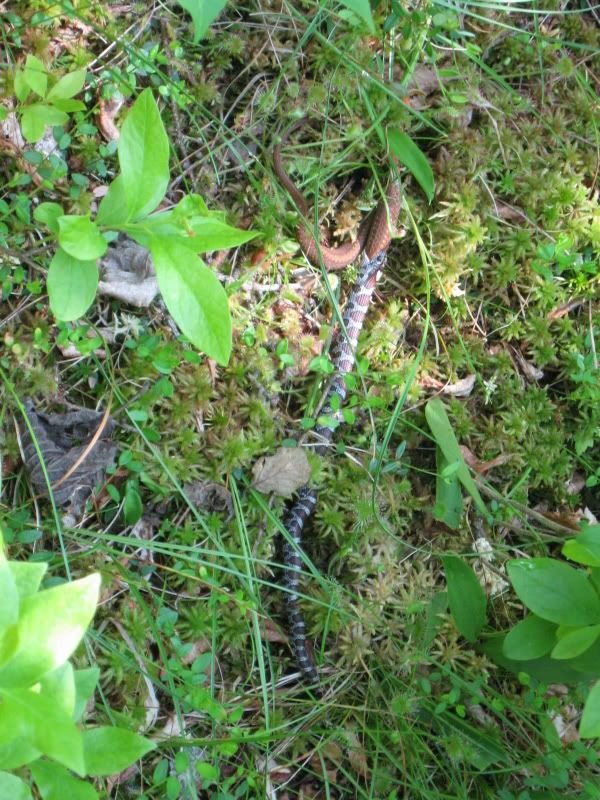I took this picture at a Wisconsin bog. On snake is trying to eat the other, but I don’t think it could ever completely do it. It looks more like a eat or be eaten situation. Can you tell what these two snake species are.
The one on the right looks like a red rat snake (aka corn snake).
The one doing the eating is a milk snake, not suire about the other one.
The eater does look like a milk snake. And other snakes are a common food source for members of the genus Lampropeltis. The eaten looks like a yellow ratsnake (genus Elaphe). But I don’t know if yellow rats extend into Wisconsin. That link (above) to snakes of Wisconsin does not mention them. But then, the snake doesn’t look like anything else the link does mention, either.
The one doing the eating is a Kingsnake. Kingsnakes can and regularly eat other snakes that are about their size or sometimes even larger. It’s difficult to tell what kind of snake is being eaten because the head isn’t visible, but I would hazard a guess that it is a rat snake of some type.
I think the milk snake is correct for the one that is eating. It looks like the first link. I found a different milk snake that doesn’t look anything like the one in the first link. What’s up. I see that the milk snake is in the king snake family. I’ll relink to be sure everybody knows what one I mean it looks like.
My first thought as well, but you’re right - it’s too far north.
I’m thinking maybe a redbelly snake:
http://www.bnl.gov/esd/reserve/images/snakes5.jpg
- Tamerlane
Maybe. At least they have longitudinal lines, as does the eaten snake.
We have nothing to indicate scale. If they are both rather small, then the eaten might be a Little Brown Snake (Storeria).
The eater is most definitely an Eastern Milk Snake, I see them on my farm here in SE WI quite often. Not sure on the eatee!
I am guessing they are both pretty small, I don’t see many Milk Snakes longer than 10". The eatee may be a Worm Snake, as found at the Massachusettes site.
There’s a lot of variation among milk snake species. They can come in some really cool colors.
There’s a grayish blue variation that I can’t find a picture for that looks really cool too. They also have anti-venom in their blood to help them devour their venomous cousins.
I left the vegetation for size reference, but I suppose I shouldn’t have expected you to realize the plant sizes. The snakes may have been up to 14 inches max.
guppy that second link is bad. it says you have to download it and not link.
Still just guessing, really-- but worm snakes are unpatterned, while brown snakes have that lengthwise striping. The black spots supposed to accompany the striping are, in my experience, often faint or missing. Also, the scalation doesn’t look smooth and glossy, as it should be for a worm snake. So, all things considered (including the fact that I don’t have any money riding on the outcome) I’d go with an Eastern Milk Snake eating a Little Brown Snake.
Guppy, the Lampropeltis group (king and milk snakes) does indeed have some of the prettiest (IMHO) of snakes.
It works right for me but maybe a mod could fix it (it is just a jet black version).
Does the coral snake ever have these variations, rendering this saying useless in the U.S.A.?
Red on yellow, kill a fellow.
Red on black, friend of Jack.
I’m surprised that I’m the first to post this: Ouroboros - Wikipedia
This works in Florida, where we have the Eastern Coral Snake and two mimics, the Scarlet Snake and the Scarlet Kingsnake. This coral snake’s red bands are always bordered by yellow bands. On the harmless mimics, the red bands are bordered by black ones.
It does NOT work in Central and South America, where the banding patterns of many coral snakes do not follow this simple rule.
For years (at our old facility) we had both the Coral Snake and the Scarlet Kingsnake on display just outside my office. I heard that poem (or some variant) uttered by a visitor or visitors virtually every working day of my life. I think I can count on the thumbs of one hand the number of times I heard it recited correctly.
I don’t know why, but people just cannot seem to keep both stanzas straight. At least not when they are actually looking at snakes.
I used to tell people to just leave unidentifed snakes alone, especially candy cane colored snakes. Or, if they really had some powerful psychological need to recite something, to simply say
“Red touch yellow, kill a fellow” and then clap their hands over their mouth.
Thanks for all the help people.
You’re welcome.
